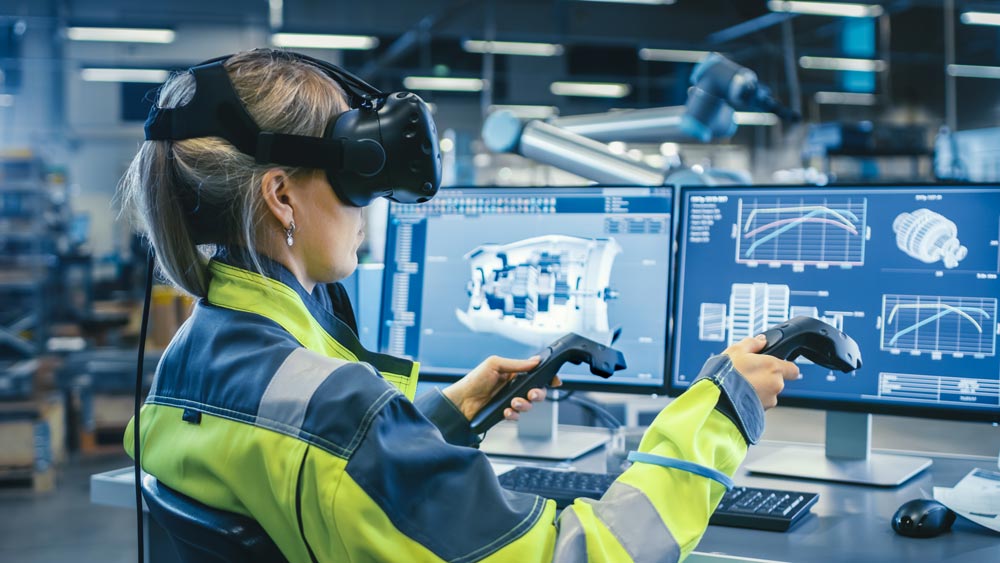Request a callback
Our latest blog post series explores how 5G private networks are revolutionising industries—with increased performance, flexibility, reliability, and security enabling autonomous vehicles, digital twins, and the factory of the future.
In this final part, we’re looking at how you can build the factory of the future with a 5G private network.
How to make Industry 4.0 work for your factory
By automating traditional manufacturing practices with smart technology and Internet of Things (IoT) devices, Industry 4.0 promises long-lasting improvements in efficiency and productivity.
“To fully benefit from Industry 4.0, you need a fast and reliable network that supports huge volumes of data, and enables more dynamic operations so you can evolve with changing demands.”
But to fully benefit, you need a fast and reliable network that supports huge volumes of data, and enables more dynamic operations so you can evolve with changing demands.
This article looks at why you need a 5G private network.
Factories that evolve to meet changing demands
The factory of the future needs to be highly flexible, letting you reconfigure your layout easily, to produce different products to meet changing demands. Rearranging machines can be costly and hazardous, but 5G connectivity means you can move them and reconnect them to the network without worrying about running network cables.
Smarter robots, smarter manufacturing
While manufacturing robots have traditionally worked on a limited range of repetitive tasks, newer generations are more flexible. They can capture data about the parts they’re working on, providing information that helps you improve performance. For this, you’ll need 5G’s consistently fast speeds.
Video is becoming more intelligent
“The factory of the future needs to be highly flexible, letting you reconfigure your layout easily, to produce different products to meet changing demands… 5G connectivity means you can move machines and reconnect them to the network without worrying about running network cables.”
Combining video and artificial intelligence (AI) improves your factory’s efficiency and productivity in multiple ways. For example, you can autonomously detect product defects across the production line. You can also create a digital twin of the machinery, for a virtual copy of the physical machine, letting you run simulations to explore potential outcomes of any changes.
You can use video with AI to improve safety too. If somebody isn’t wearing the right safety equipment, or has entered a hazardous area, you can be alerted instantly, to maintain high safety standards.
For all this to work, you need a network that enables large volumes of data to be quickly and consistently transmitted.
See your factory in new ways with AR and VR
Augmented reality (AR)—which allows you to superimpose digital information over a live view of your surroundings—lets engineers and equipment manufacturers remotely diagnose any issues with your machines.
You won’t have to wait for an engineer to visit your factory, and you can order replacement parts straight away. Engineers can use two-way video communication with interactive digital overlays, to assist onsite maintenance workers by visually highlighting which parts to work on.
Virtual reality (VR) lets you simulate and physically interact with virtual 3D objects and environments—especially useful when planning a new factory layout.
AR and VR both require a high-bandwidth, low-latency network for stable video imagery—jitter can cause nausea for headset users. VR tends to be used in self-contained environments, so a wired system is often adequate. But as you might use AR anywhere across your factory, a 5G private network delivers the consistent performance you need.
Why 5G, not Wi-Fi, is the key to a smarter factory
The use cases mentioned above are made possible by the flexibility you enable with wireless networks, with the recommendation to use a 5G private network. So, why not just use your existing Wi-Fi network?
When building your smart factory, 5G gives you the edge over Wi-Fi. It supports a million devices per km2, so you’ll never experience connections degrading as you add more devices, whereas the quality of Wi-Fi connections is heavily impacted by the requirements of each device. And with latency as low as 1ms and a speed of 10Gbps, 5G communication remains fast and reliable.
A 5G private network gives you the added benefit of a licenced spectrum, which means you won’t be competing with 5G connections from outside your business, so there’s no chance of interference.
“The latest advances in Industry 4.0. and IoT technology mean your factory has a bright future ahead of it—but you need wireless connectivity that can keep up. To build the factory of the future, you need a 5G private network.”
Factories are often full of moving, metallic machines—environments where Wi-Fi struggles to maintain connectivity. For example. Airbus uses thousands of smart screwdrivers, which intelligently control the torque used. But a Wi-Fi connection means maintenance crews often lose signal while they’re working. Your 5G private network would ensure smart tools work reliably.
The latest advances in Industry 4.0. and IoT technology mean your factory has a bright future ahead of it—but you need wireless connectivity that can keep up. To build the factory of the future, you need a 5G private network.


